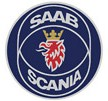 | |
| Predecessors | |
|---|---|
| Founded | 1969 |
| Defunct | 1995 |
| Fate | Split |
| Successors | |
| Headquarters | Sweden |

Saab-Scania AB was a Swedish vehicle manufacturer that was formed from the 1969 merger of Saab AB and Scania-Vabis. The company was split in 1995.
 | |
| Predecessors | |
|---|---|
| Founded | 1969 |
| Defunct | 1995 |
| Fate | Split |
| Successors | |
| Headquarters | Sweden |

Saab-Scania AB was a Swedish vehicle manufacturer that was formed from the 1969 merger of Saab AB and Scania-Vabis. The company was split in 1995.
Truck and bus manufacturer Scania AB of Södertälje merged with car and aeroplane manufacturer Saab AB of Trollhättan on 1 September 1969, [1] [2] under the Wallenberg family group of companies. The merger meant that Saab no longer had to import the British Triumph Slant-4 engine, and could instead use the engine production facilities of Scania. In 1972 they started manufacturing the 2.0 L B version. In 1977, Saab took advantage of Scania's experience with turbochargers and added one to the engine, thus creating one of the earliest turbocharged automobile engines to be produced in large numbers.[ citation needed ]
When the corporation was split in 1995, the name of the truck and bus division changed back to Scania AB. Saab Aircraft (Saab AB) and Saab cars were also split, with General Motors buying a major holding in Saab Automobile AB.
Saab-Scania consisted of following divisions:
Saab-Scania had following subsidiaries: